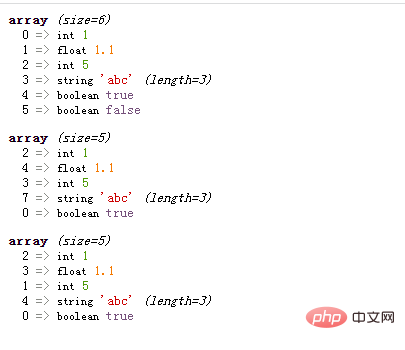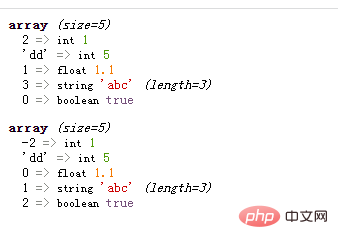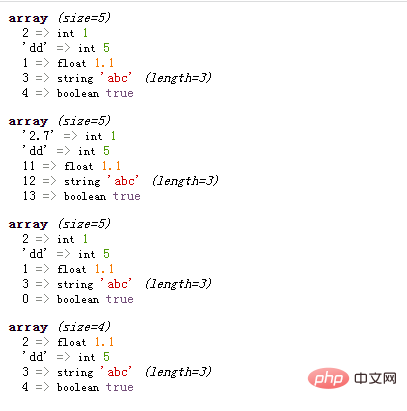Do array subscripts in php have to be consecutive?
PHP array subscripts may not be consecutive. In PHP, the subscript of an array can be an integer or a string; the order of the elements of the array is not determined by the subscript, but by the order in which they are "joined". The subscripts of PHP arrays can be set arbitrarily without order or continuity. For example, "array(2=>1,4=>1.1,3=>5,7=>'abc',0=> ;true); ".

The operating environment of this tutorial: windows7 system, PHP8.1 version, DELL G3 computer
Array basics:
In php, the subscript of the array can be an integer or a string
In php, the order of the elements of the array is not determined by the subscript, but by its " The order of joining" determines
Definition:
$arr = array(元素1,元素2,...);
Example 1:
$arr1 = array(1,1.1,5,'abc',true,false); //可以存储任何数据,此时为默认下标 $arr2 = array(2=>1,4=>1.1,3=>5,7=>'abc',0=>true); //下标可任意设定(无需顺序,无需连续) $arr3 = array(2=>1,1.1,1=>5,'abc',0=>true); //可以加下标,也可以不加,不加下标则为默认下标 //默认下标规则:前面已经用过的最大数字下标+1 //这个数字的下标分别是:2,3,1,4,0

Example 2:
$arr1 = array(2=>1,'dd'=>5,1=>1.1,'abc',0=>true); //混合下标,同样遵循默认下标规则 $arr2 = array(-2=>1,'dd'=>5,1.1,'abc',true); //负数下标不算在整数下标中,而只当作字符下标 //则这个数组最后三项的下标为:0,1,2

Example 3:
$arr1 = array(2.7=>1,'dd'=>5,1=>1.1,'abc',true); //浮点数下标会自动转换为整数,且直接去掉小数部分
$arr2 = array("2.7"=>1,'dd'=>5,"11"=>1.1,'abc',true); //纯数字字符串下标,当作数字看待
$arr3 = array(2=>1,'dd'=>5,true=>1.1,'abc',false=>true); //布尔值当作下标,则true为1,false为0
$arr4 = array(2=>1,'dd'=>5,2=>1.1,'abc',true); //如果下标跟前面的重复,则单纯覆盖前面同名下标的值
## Other forms of defining arrays:
$arr1[] = 1; $arr1[] = 5; $arr1[] = 1.1; ...... //直接在变量后面使用[],就成为数组,并依次赋值
$arr2['aa'] = 1; $arr2['bb'] = 5; $arr2[5] = 1.1; ...... //这种形式写的下标,其实跟使用array语法结构几乎一样
Classification of arrays:
From key-value relationship Divided into:
- Associative array: usually refers to an array whose subscript is a string, and the string can roughly express the meaning of the dataExample :
$person = array("name" => "poe", "age" => 18, "edu" => "大学毕业");- Index array: usually refers to an array's subscript strictly starting from 0 and consecutive numeric subscripts--similar to js array
Divided from the array level:
- One-dimensional array: Each element value in an array is An ordinary value (non-array value)Example:
$person = array("name" => "poe", "age" => 18, "edu" => "大学毕业");- Two-dimensional array: Each item in an array is another One-dimensional array.
$person = array(
"name" => array("xiaohua","xiaofang),
"age" => array(18,22),
"edu" => array("大学毕业","小学",)
);- Multidimensional array: and so on. . . General syntax form of multi-dimensional arrays:
$v1 = 数组名[下标][下标][......]
Traversal of arrays:
Basic syntax for traversal:
foreach($arr as [$key =>] $value) {
//这里就可以对$key and $value进行所有可能的操作 -- 因为他们就是一个变量
//$key代表每次取得元素的下标,可能是数字,也可以是字符串
//$value代表每次取得元素的值,可能是各种类型
//此循环结构会从数组的第一项一直遍历到最后一项,然后结束
}Array pointers and traversal principles:
Each array has a "pointer" inside it, which determines The elements obtained when the array is currently evaluated During the foreach traversal process, they all rely on this pointer. Example:$arr1 = array(2=>1,'dd'=>5,1=>1.1,'abc',0=>true);
$v1 = current($arr1); //Get the value of the element pointed to by the current pointer in $arr1. If it does not point to an element, it is false
$v1 = key($arr1 ); //Get the subscript of the element pointed to by the current pointer in $arr1. . . . . . . . . . . . .
$v1 = next($arr1); //Move the pointer to the "next element", and then get the value of the next element
$v1 = prev($arr1); //Move the pointer to the "previous element", and then get the value of the previous element
$v1 = reset($arr1); //Move the pointer to the "first element" and get the value of the element
$v1 = end($arr1); //Move the pointer to the "last element" and get the value of the element
$v1 = each($arr1); //Get the subscript of the current element and value, then move the pointer to the next position
PHP Video Tutorial"
The above is the detailed content of Do array subscripts in php have to be consecutive?. For more information, please follow other related articles on the PHP Chinese website!

Hot AI Tools

Undresser.AI Undress
AI-powered app for creating realistic nude photos

AI Clothes Remover
Online AI tool for removing clothes from photos.

Undress AI Tool
Undress images for free

Clothoff.io
AI clothes remover

AI Hentai Generator
Generate AI Hentai for free.

Hot Article

Hot Tools

Notepad++7.3.1
Easy-to-use and free code editor

SublimeText3 Chinese version
Chinese version, very easy to use

Zend Studio 13.0.1
Powerful PHP integrated development environment

Dreamweaver CS6
Visual web development tools

SublimeText3 Mac version
God-level code editing software (SublimeText3)

Hot Topics
 1359
1359
 52
52
 CakePHP Project Configuration
Sep 10, 2024 pm 05:25 PM
CakePHP Project Configuration
Sep 10, 2024 pm 05:25 PM
In this chapter, we will understand the Environment Variables, General Configuration, Database Configuration and Email Configuration in CakePHP.
 PHP 8.4 Installation and Upgrade guide for Ubuntu and Debian
Dec 24, 2024 pm 04:42 PM
PHP 8.4 Installation and Upgrade guide for Ubuntu and Debian
Dec 24, 2024 pm 04:42 PM
PHP 8.4 brings several new features, security improvements, and performance improvements with healthy amounts of feature deprecations and removals. This guide explains how to install PHP 8.4 or upgrade to PHP 8.4 on Ubuntu, Debian, or their derivati
 CakePHP Date and Time
Sep 10, 2024 pm 05:27 PM
CakePHP Date and Time
Sep 10, 2024 pm 05:27 PM
To work with date and time in cakephp4, we are going to make use of the available FrozenTime class.
 CakePHP Working with Database
Sep 10, 2024 pm 05:25 PM
CakePHP Working with Database
Sep 10, 2024 pm 05:25 PM
Working with database in CakePHP is very easy. We will understand the CRUD (Create, Read, Update, Delete) operations in this chapter.
 CakePHP File upload
Sep 10, 2024 pm 05:27 PM
CakePHP File upload
Sep 10, 2024 pm 05:27 PM
To work on file upload we are going to use the form helper. Here, is an example for file upload.
 CakePHP Routing
Sep 10, 2024 pm 05:25 PM
CakePHP Routing
Sep 10, 2024 pm 05:25 PM
In this chapter, we are going to learn the following topics related to routing ?
 Discuss CakePHP
Sep 10, 2024 pm 05:28 PM
Discuss CakePHP
Sep 10, 2024 pm 05:28 PM
CakePHP is an open-source framework for PHP. It is intended to make developing, deploying and maintaining applications much easier. CakePHP is based on a MVC-like architecture that is both powerful and easy to grasp. Models, Views, and Controllers gu
 CakePHP Creating Validators
Sep 10, 2024 pm 05:26 PM
CakePHP Creating Validators
Sep 10, 2024 pm 05:26 PM
Validator can be created by adding the following two lines in the controller.






